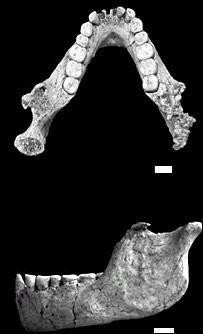The new discoveries include missing parts of the first skeleton - called LB1 after the cave at the Liang Boa excavation site as well as a collection of additional bones including a jaw and parts of the skull, vertebral bones and legs, toes and fingers.

Scientists have discovered more remains of the strange little people who once lived on the island of Flores, Indonesia.
The announcement last year that described parts of a single skeleton found caused a sensation when it was claimed that this was a new human species to science. Homo fluoresiensis, that's his name, was only a little over a meter tall, and lived about eighteen thousand years ago. Now, the same team reported to the newspaper "Nature" that they found skeletal remains of at least nine "Hobbit"-like individuals.
The new discoveries include missing parts of the first skeleton - called LB1 after the cave at the Liang Boa excavation site as well as a collection of additional bones including a jaw and parts of the skull, vertebral bones and legs, toes and fingers.
The team, led by Michael Morwood of the University of New England in Armadale, Australia, said the samples helped build a more complete picture of LB1, with further evidence of the little people's hunting and fire-making abilities.
In doing so, the researchers hope to disprove the claim that was made against them as if it were an individual of a female who suffered from a rare bone disease and not as a representative of an entire human species in its own right. (See link "Neither Hobbit nor Plaster")
* Thanks to reader Eliasaf Mobshevitz for his help in translating this news
